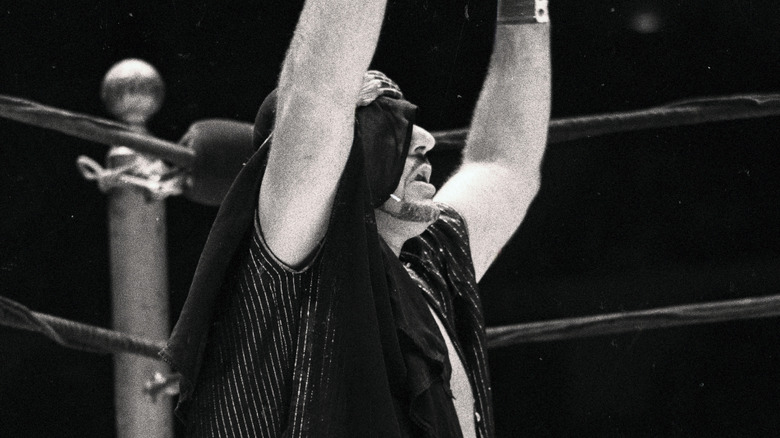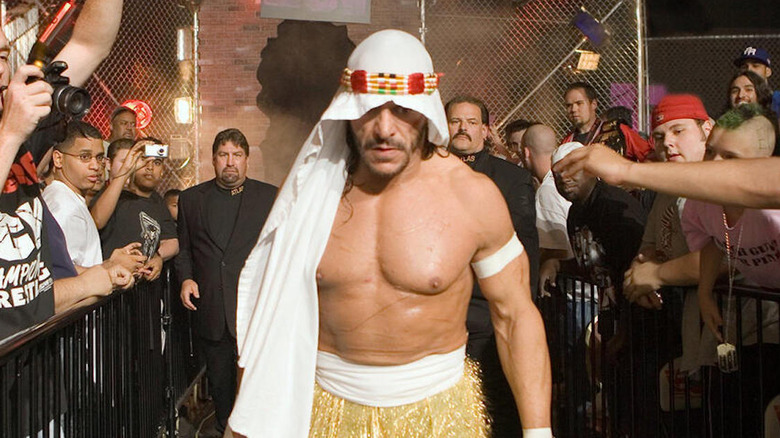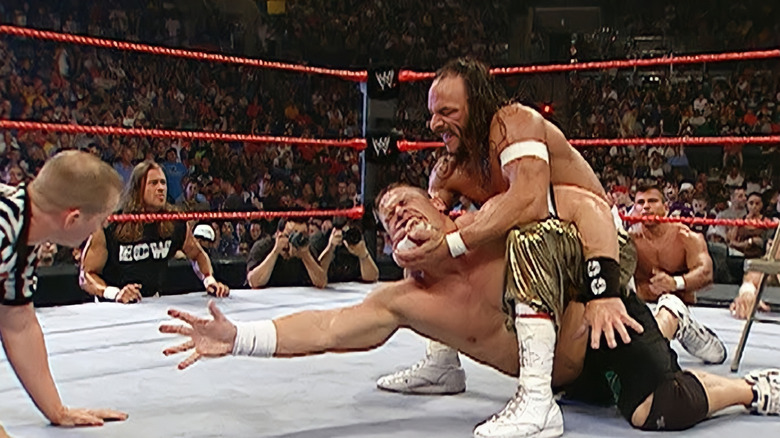The Tragic Side Of Sabu's Real Life
The wrestling world lost Terrence Brunk, better known as Sabu over the weekend. Initially reported to be 60-years-old at the time of his death, Sabu was revealed by court documents to be 61. The cause of death is still not known.
Sabu's legacy in wrestling is one written in blood, barbed wire, and fire. The ultraviolent style he championed ultimately took a toll on his body. Despite wrestling in every promotion from WWE to WCW to ECW to NJPW and beyond, Sabu's life was marked with tragedy and hardship. Even his retirement match, controversial as it was at the time, was marked by controversy when it was later revealed that he might not have been as medically able to compete as fans initially thought.
Much like his uncle, "The Sheik" Ed Farhat, Sabu's body was racked with pain through most of his career. The bridge between Sheik's hardcore innovations and today's regularly extreme style, Sabu was one of the true innovators of the professional wrestling business, essentially sacrificing his own body to push the wrestling business into new frontiers.
A Legacy Of Suffering
By choosing to follow in his uncle's footsteps, Sabu essentially guaranteed that life would come with a certain amount of pain and suffering. Detroit-based promoter, "The Sheik" Ed Farhat, was known for using fire and spikes to mutilate his opponents. Sabu had a deep connection with his uncle, due to a troubled home life, and after a brush with death, Sabu asked the Sheik to train him.
Before ever setting foot in a wrestling ring, Sabu ended up in a confrontation with an armed man. The scuffle led to the man's gun being put near Sabu's mouth and going off. Sabu survived being shot in the face, with his teeth and his jaw taking the brunt of the damage. Before Sabu had even recovered from the gunshot, Sheik told him to pack his bags and begin wrestling training.
During Sabu's time training and working with his uncle, the Sheik took on another student in 1989, Robert Szatkowski. Sabu and Szatkowski would spend the rest of their careers intertwined, as Szatkowski took on the name "Rob Van Dam," and the rest was ECW history.
The Land of Extreme
Sabu's 90s heyday was synonymous with the rise of the extreme, Philadelphia-based promotion Extreme Championship Wrestling. Alongside the likes of Raven, the Sandman, Tommy Dreamer, and others, Sabu innovated his trademark extreme style in the South Philly Viking Hall, even performing for a young ECW fan named Tony Khan, who would later go on to bring Sabu to his promotion AEW.
Rivalries with the likes of Rob Van Dam and Taz launched Sabu into superstardom, traveling the world to promotions like New Japan Pro Wrestling. Unfortunately, Sabu's success was never able to be maintained at a certain level. The former ECW World Champion joined WCW during the company's mid-90s boom period, but despite introducing WCW fans to things like tables and Arabian Moonsaults, his eccentric personality and less-than-family-friendly style led to his tenure being short-lived. Not long after, he was back in ECW, continuing to put his body on the line.
Not only was he massacring himself and his opponents on a weekly basis, but he was doing so for a less-than-reputable promoter. Despite his lofty reputation now, WWE Hall of Famer Paul Heyman was known for cutting a corner or two while running ECW, even skimping on payment.
Elder Statesman Of Hardcore
ECW eventually shuttered in 2001. This left wrestlers like Sabu without many options, as WCW also shuttered just weeks later. Sabu soon found himself on the independent scene, once again battering his body for low pay. He eventually ended up in TNA Wrestling, where he was again called on to throw himself through barbed wire and thumbtacks, especially in matches with Abyss.
In 2006, WWE revived ECW as a third brand, and suddenly, an influx of extreme wrestlers happened. Sabu, Sandman, Balls Mahoney, and other ECW originals arrived in WWE, while Sabu's friend Rob Van Dam even won the WWE Championship as a show of changing times. While many ECW stars were used for nostalgia or comedic relief, Sabu found himself thrust into the spotlight, facing the face of WWE, John Cena, at the Vengeance PPV in an Extreme Lumberjack match. Sabu was quickly injured during his time in WWE, and never found his footing in the company once he returned. He left in 2007, once again ending up in the independent scene.
Sabu was brought to AEW, helping Adam Cole defeat Chris Jericho at AEW Double or Nothing in 2023, but for the most part Sabu worked for promotions like GCW. The realities of deathmatch bookings were made grimly clear recently, as Sabu's opponent in his retirement match, Joey Janela, revealed that Sabu was in rough shape before his final match. According to Janela, Sabu couldn't walk, and was given the legal drug Kratom to help him work the final match pain-free. Sabu suffered a concussion, adding further controversy, but managed to finish the match, defeating Janela in an awkward, uncomfortable display. Just weeks later, he was gone.



